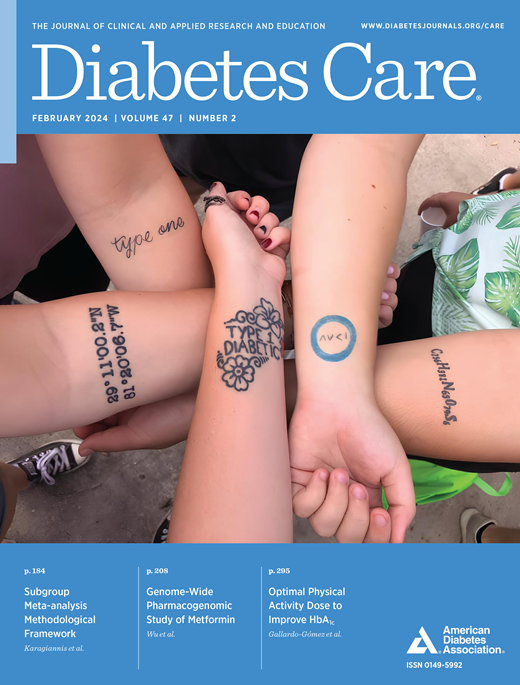糖尿病酮症酸中毒发病、糖尿病技术吸收和1年和2年随访后临床结果的关联:一项来自9个国家的9269例1型糖尿病儿童儿科登记的合作分析
IF 16.6
1区 医学
Q1 ENDOCRINOLOGY & METABOLISM
引用次数: 0
摘要
目的:本研究探讨1型糖尿病诊断时糖尿病酮症酸中毒(DKA)与青少年长期血糖结局、胰岛素需求、BMI SDS和糖尿病技术摄取之间的关系。研究设计和方法数据来自9个国家(奥地利、捷克、德国、意大利、卢森堡、新西兰、斯洛文尼亚、瑞士和美国[科罗拉多州]),包括2019-2020年诊断为1型糖尿病的年轻人(0.5-15.9岁),此后随访2年。参与者被分为三组:诊断时无DKA、非严重DKA和严重DKA。评估了HbA1c、胰岛素需求、BMI SDS和技术的使用,包括自动胰岛素输送(AID)。结果共纳入9269例,其中男性54.8%,平均年龄9.0岁。诊断时DKA发生率为34.2%,重度DKA发生率为12.8%。1年后,重度DKA组的调整后平均HbA1c(7.41%)高于非重度DKA组(7.23%,P = 0.001)和无DKA组(7.14,P <;0.001),这种差异在2年后仍然存在(7.58% vs. 7.38%;0.001]和7.32% [P <;0.001])。与未服用DKA的患者相比,两组患者的BMI SDS均较高。与其他治疗方式相比,AID的使用与较低的HbA1c水平相关,并且在2年随访后,DKA组之间的差异有所缓和(P = 0.072)。结论:1型糖尿病诊断时严重和非严重DKA均与持续较高的HbA1c和较高的BMI SDS相关。随着时间的推移,AID的使用降低了诊断时DKA与较高HbA1c的相关性。本文章由计算机程序翻译,如有差异,请以英文原文为准。
Association of Diabetic Ketoacidosis at Onset, Diabetes Technology Uptake, and Clinical Outcomes After 1 and 2 Years of Follow-up: A Collaborative Analysis of Pediatric Registries Involving 9,269 Children With Type 1 Diabetes From Nine Countries
OBJECTIVE This study examined the association between diabetic ketoacidosis (DKA) at type 1 diabetes diagnosis and long-term glycemic outcomes, insulin requirements, BMI SDS, and diabetes technology uptake in youth. RESEARCH DESIGN AND METHODS Data were from nine countries (Austria, Czechia, Germany, Italy, Luxembourg, New Zealand, Slovenia, Switzerland, and U.S. [Colorado]), including youth (0.5–15.9 years) diagnosed with type 1 diabetes in 2019–2020 and followed for 2 years thereafter. Participants were divided into three groups: no DKA, nonsevere, and severe DKA at diagnosis. HbA1c, insulin requirements, BMI SDS, and use of technology, including automated insulin delivery (AID), were assessed. RESULTS The analysis included 9,269 individuals (54.8% males, mean age 9.0 years). DKA at diagnosis was observed in 34.2% of participants and severe DKA in 12.8%. After 1 year, adjusted mean HbA1c was higher in the severe DKA group (7.41%) compared with nonsevere DKA (7.23%, P = 0.001) and no DKA groups (7.14, P < 0.001), and this difference persisted after 2 years (7.58% vs. 7.38% [P < 0.001] and vs. 7.32% [P < 0.001]). Higher BMI SDS was observed in both DKA groups compared with no DKA. The use of AID was associated with lower HbA1c levels compared with other treatment modalities and moderated differences between DKA groups after 2 years of follow-up (P = 0.072). CONCLUSIONS Severe and nonsevere DKA at type 1 diabetes diagnosis were both associated with persistently higher HbA1c and higher BMI SDS. AID use diminishes the association of DKA at diagnosis and higher HbA1c over time.
求助全文
通过发布文献求助,成功后即可免费获取论文全文。
去求助
来源期刊

Diabetes Care
医学-内分泌学与代谢
CiteScore
27.80
自引率
4.90%
发文量
449
审稿时长
1 months
期刊介绍:
The journal's overarching mission can be captured by the simple word "Care," reflecting its commitment to enhancing patient well-being. Diabetes Care aims to support better patient care by addressing the comprehensive needs of healthcare professionals dedicated to managing diabetes.
Diabetes Care serves as a valuable resource for healthcare practitioners, aiming to advance knowledge, foster research, and improve diabetes management. The journal publishes original research across various categories, including Clinical Care, Education, Nutrition, Psychosocial Research, Epidemiology, Health Services Research, Emerging Treatments and Technologies, Pathophysiology, Complications, and Cardiovascular and Metabolic Risk. Additionally, Diabetes Care features ADA statements, consensus reports, review articles, letters to the editor, and health/medical news, appealing to a diverse audience of physicians, researchers, psychologists, educators, and other healthcare professionals.
 求助内容:
求助内容: 应助结果提醒方式:
应助结果提醒方式:


